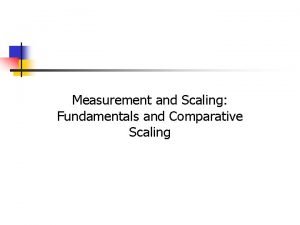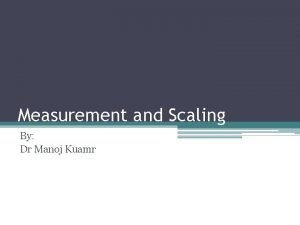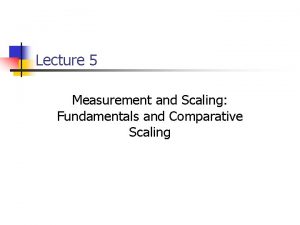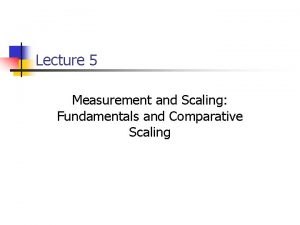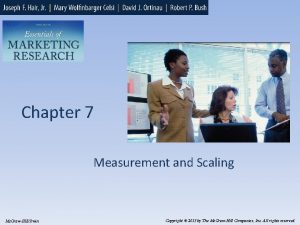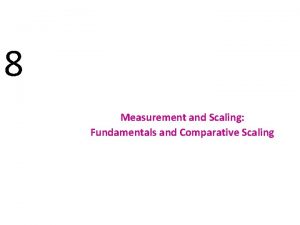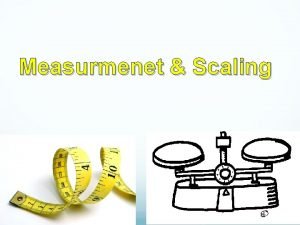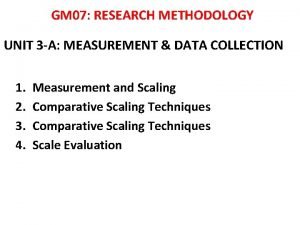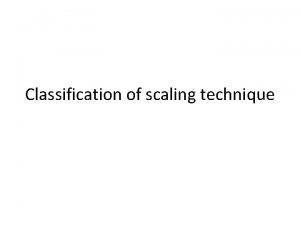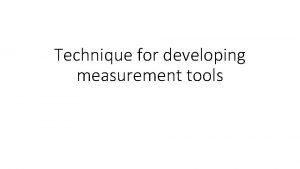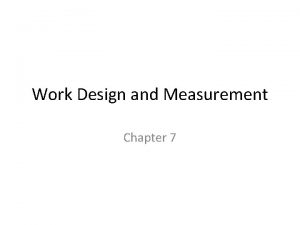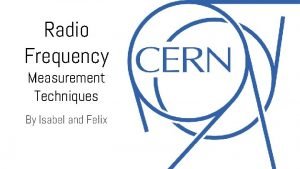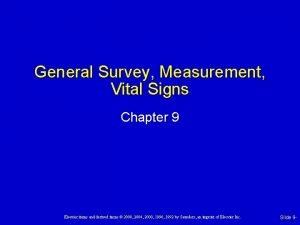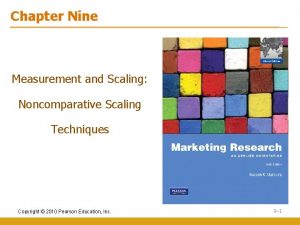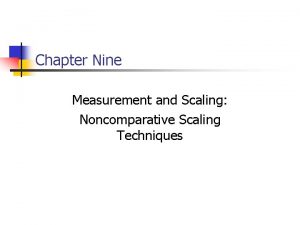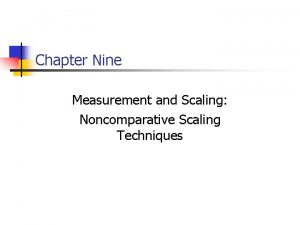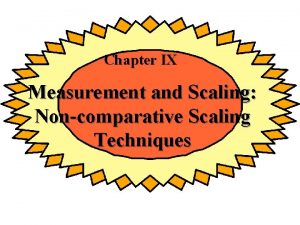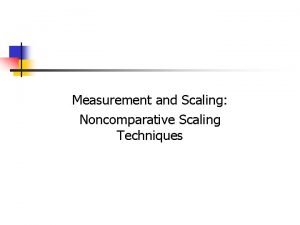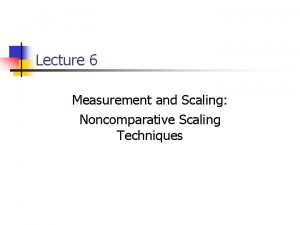Chapter Nine Measurement and Scaling Noncomparative Scaling Techniques














- Slides: 14

Chapter Nine Measurement and Scaling: Noncomparative Scaling Techniques Copyright © 2010 Pearson Education, Inc. publishing as Prentice Hall 9 -1

Noncomparative Scaling Techniques • Respondents evaluate only one object at a time, and for this reason non-comparative scales are often referred to as monadic scales. • Non-comparative techniques consist continuous and itemized rating scales. Copyright © 2010 Pearson Education, Inc. publishing as Prentice Hall of 9 -2

Continuous Rating Scale Respondents rate the objects by placing a mark at the appropriate position on a line that runs from one extreme of the criterion variable to the other. The form of the continuous scale may vary considerably. How would you rate Sears as a department store? Version 1 Probably the worst - - - -I - - - - - - Probably the best Version 2 Probably the worst - - - -I - - - - - --Probably the best 0 10 20 30 40 50 60 70 80 90 100 Version 3 Very bad Neither good Very good nor bad Probably the worst - - - -I - - - - - ---Probably the best 0 10 20 30 40 50 60 70 80 90 100 Copyright © 2010 Pearson Education, Inc. publishing as Prentice Hall 9 -3

Itemized Rating Scales • The respondents are provided with a scale that has a number or brief description associated with each category. • The categories are ordered in terms of scale position, and the respondents are required to select the specified category that best describes the object being rated. • The commonly used itemized rating scales are the Likert, semantic differential, and Stapel scales. Copyright © 2010 Pearson Education, Inc. publishing as Prentice Hall 9 -4

Likert Scale The Likert scale requires the respondents to indicate a degree of agreement or disagreement with each of a series of statements about the stimulus objects. 1. Sears sells high-quality merchandise. 2. Sears has poor in-store service. 3. I like to shop at Sears. Strongly disagree Disagree Neither Agree agree nor disagree Strongly agree 1 2 X 3 4 5 1 2 3 X 4 5 • The analysis can be conducted on an item-by-item basis (profile analysis), or a total (summated) score can be calculated. • When arriving at a total score, the categories assigned to the negative statements by the respondents should be scored by reversing the scale. Copyright © 2010 Pearson Education, Inc. publishing as Prentice Hall 9 -5

Semantic Differential Scale The semantic differential is a seven-point rating scale with end points associated with bipolar labels that have semantic meaning. SEARS IS: Powerful --: --: -X-: --: Weak Unreliable --: --: --: -X-: --: Reliable Modern --: --: --: -X-: Old-fashioned • The negative adjective or phrase sometimes appears at the left side of the scale and sometimes at the right. • This controls the tendency of some respondents, particularly those with very positive or very negative attitudes, to mark the right- or left-hand sides without reading the labels. • Individual items on a semantic differential scale may be scored on either a -3 to +3 or a 1 to 7 scale. Copyright © 2010 Pearson Education, Inc. publishing as Prentice Hall 9 -6

A Semantic Differential Scale for Measuring Self. Concepts, Person Concepts, and Product Concepts 1) Rugged 2) Excitable 3) Uncomfortable 4) Dominating 5) Thrifty : ---: ---: Delicate : ---: ---: Calm : ---: ---: Comfortable : ---: ---: Submissive : ---: ---: Indulgent 6) Pleasant : ---: ---: Unpleasant 7) Contemporary : ---: ---: Obsolete 8) Organized : ---: ---: Unorganized 9) Rational : ---: ---: Emotional 10) Youthful 11) Formal 12) Orthodox 13) Complex 14) Colorless 15) Modest : ---: ---: Mature : ---: ---: Informal : ---: ---: Liberal : ---: ---: Simple : ---: ---: Colorful : ---: ---: Vain Copyright © 2010 Pearson Education, Inc. publishing as Prentice Hall 9 -7

Stapel Scale The Stapel scale is a unipolar rating scale with ten categories numbered from -5 to +5, without a neutral point (zero). This scale is usually presented vertically. SEARS +5 +4 +3 +2 +1 HIGH QUALITY -1 -2 -3 -4 X -5 +5 +4 +3 +2 X +1 POOR SERVICE -1 -2 -3 -4 -5 The data obtained by using a Stapel scale can be analyzed in the same way as semantic differential data. Copyright © 2010 Pearson Education, Inc. publishing as Prentice Hall 9 -8

Balanced and Unbalanced Scales Fig. 9. 1 Jovan Musk for Men is: Extremely good Very good Good Bad Very bad Extremely bad Jovan Musk for Men is: Extremely good Very good Good Somewhat good Bad Very bad Copyright © 2010 Pearson Education, Inc. publishing as Prentice Hall 9 -9

Scale Evaluation Fig. 9. 5 Scale Evaluation Reliability Test/ Retest Alternative Forms Validity Internal Consistency Content Criterion Convergent Copyright © 2010 Pearson Education, Inc. publishing as Prentice Hall Generalizability Construct Discriminant Nomological 9 -10

Reliability • In test-retest reliability, respondents are administered identical sets of scale items at two different times and the degree of similarity between the two measurements is determined. • In alternative-forms reliability, two equivalent forms of the scale are constructed and the same respondents are measured at two different times, with a different form being used each time. Copyright © 2010 Pearson Education, Inc. publishing as Prentice Hall 9 -11

Reliability • Internal consistency reliability determines the extent to which different parts of a summated scale are consistent in what they indicate about the characteristic being measured. • The coefficient alpha, or Cronbach's alpha, is the average of all possible split-half coefficients resulting from different ways of splitting the scale items. This coefficient varies from 0 to 1, and a value of 0. 6 or less generally indicates unsatisfactory internal consistency reliability. Copyright © 2010 Pearson Education, Inc. publishing as Prentice Hall 9 -12

Validity • Content validity is a subjective but systematic evaluation of how well the content of a scale represents the measurement task at hand. • Criterion validity reflects whether a scale performs as expected in relation to other variables selected (criterion variables) as meaningful criteria. Copyright © 2010 Pearson Education, Inc. publishing as Prentice Hall 9 -13

Validity • Construct validity addresses the question of what construct or characteristic the scale is, in fact, measuring. Construct validity includes convergent, discriminant, and nomological validity. • Convergent validity is the extent to which the scale correlates positively with other measures of the same construct. • Discriminant validity is the extent to which a measure does not correlate with other constructs from which it is supposed to differ. • Nomological validity is the extent to which the scale correlates in theoretically predicted ways with measures of different but related constructs. Copyright © 2010 Pearson Education, Inc. publishing as Prentice Hall 9 -14
 Nominal scale of measurement
Nominal scale of measurement Measurement and scaling
Measurement and scaling Measurement and scaling
Measurement and scaling What is comparative scale
What is comparative scale Ratio scale
Ratio scale Comparative scaling
Comparative scaling Measurmenet
Measurmenet Constant-sum scale
Constant-sum scale Nominal scale ordinal
Nominal scale ordinal Technique of developing measurement tool involves
Technique of developing measurement tool involves Powder flow measurement techniques
Powder flow measurement techniques Work measurement techniques
Work measurement techniques High frequency measurement techniques
High frequency measurement techniques Fonctions techniques et solutions techniques
Fonctions techniques et solutions techniques Chapter 9 general survey and measurement
Chapter 9 general survey and measurement
